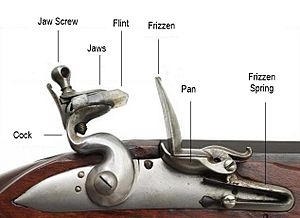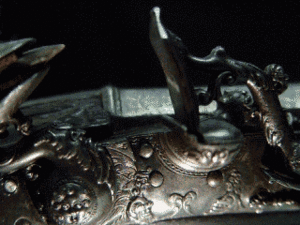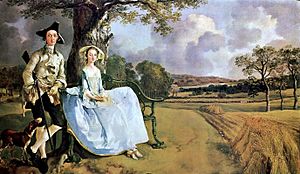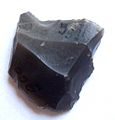Flintlock facts for kids
A flintlock is a type of firearm that uses a special way to fire. It can also mean just the firing part itself. A flintlock works by holding a piece of flint in a clamp. When you pull the trigger, a hammer with the flint attached swings down. It hits a steel part called a "frizzen." This creates a spark. The spark ignites the gunpowder in a small pan right below the flint.
Through a tiny hole, this flame then lights the main powder charge inside the gun's breech. This makes the gun fire its round ball, shot, or bullet. The flintlock was a very popular type of musket for more than 200 years. Flintlocks were made with smoothbore barrels and later with rifled gun barrels, which made them more accurate.
How Flintlocks Started
The very first type of flintlock appeared in 1570. It was called a snaphaunce. Around 1630, a Frenchman named Marin le Bourgeoys created what we call the "true" flintlock. It was also known as the "French lock." Bourgeoys worked for King Louis XIII of France. He designed this new firing mechanism for the king.
The French lock made the Snaphaunce design simpler. It combined two parts into one L-shaped frizzen. This is the style you see on most flintlocks today. At first, flintlocks were used for smoothbore long guns, like muskets. But soon, they were also used for shotguns and pistols. Officers on sailing ships and in the army often carried flintlock pistols.
Famous Flintlock Guns
Long Guns
- Brown Bess Musket
The British Land Pattern Musket was commonly called the "Brown Bess". It was made between 1725 and 1838. All versions of the Land Pattern were .75 caliber smoothbore muskets. These were the standard guns for all land forces in the British Empire. They were replaced after 1838 by smoothbore percussion cap muskets. The Brown Bess was effective up to about 100 yards (91 m). However, in most battles, forces were only about 50 yards (46 m) apart. Even at that distance, the gun was not very accurate. The British army's plan was to fire in vollies (all at once) and then charge with bayonets.
- Pennsylvania Rifle
This rifle was later called the "Kentucky rifle" after the early 1880s. The Pennsylvania rifle came from earlier, heavier Jaeger rifles. German gunsmiths brought these to the American colonies. During the American Revolutionary War, companies of Pennsylvania riflemen caused problems behind the British lines. They could target individual soldiers and officers from far away. This was well out of range of the British Brown Bess muskets.
- Springfield Model 1795 Musket
This musket was based on the French Charleville musket. It was the first U.S. flintlock musket made at the Springfield Armory. Eli Whitney designed it. It was also the first gun to use interchangeable parts. About 10,000 of these muskets were given to the US Army. They were used in the War of 1812.
- Fusil de Chasse
This French term means "hunting gun." By the mid-18th century, a light flintlock musket carried by an officer was called a fusil. This name came from the Italian word fucile, meaning flint. Both the French and the British had their own versions of the officer's fusil. The term fusilier came from this name. British officers on foot originally carried a spontoon (a type of spear). Later, this pole weapon was replaced by the officer's fusil. A very similar but cheaper version was the "fusil de traite" (trade gun). The officer's fusil could have a sling. Its stock was 4 inches (100 mm) shorter than the barrel to fit a bayonet. The officer's fusil was much better made. At 20 gauge (.62 caliber), the fusil was also used for hunting birds, like an early shotgun. Some American officers in the Revolutionary War also carried fusils.
Pistols
-
French cavalry style flintlock pistol
- Kentucky Pistol
This pistol was first made around the turn of the 17th century. It has stayed mostly the same since then. It could be a bit awkward for new users to load. The Kentucky pistol sometimes had a "hang fire." This means the flint hits the frizzen and lights the powder in the pan, but it burns slowly like a fuse. When this happens, it's important to keep the gun pointed at the target until it fires. This gun was usually .50 caliber and had an octagonal barrel. The stock was often made of curly maple wood. It usually had a wooden ramrod with a brass tip.
- Duelling Pistols
These were not a specific gun model, but a type of flintlock weapon. Duelling pistols were made in matched pairs. They usually came in a special case. They were often fancy and highly decorated guns. They were meant to be used in a duel. Until the 19th century, most were single-shot flintlock pistols. Like other flintlock pistols, there was a noticeable delay between pulling the trigger and the gun firing.
Images for kids
-
An English gentleman around 1750 with his flintlock muzzle-loading sporting rifle, in a painting by Thomas Gainsborough.
-
A flintlock musket being fired
See also
 In Spanish: Arma de chispa para niños
In Spanish: Arma de chispa para niños



















